ON December 7 1941 the Japanese bombed Pearl Harbor, the US navy base on Oahu, Hawaii. The attack was a declaration of war on Britain and the United States. Thousands were killed.
Relations with the United States had been deteriorating since 1931 when Japan occupied Manchuria in northern China. Japan and China had been at war since 1937. In 1940, the US imposed trade sanctions on Japan, hitting the Japanese with embargoes on aviation fuel and iron. In September 1940 Japan became a member of the Axis powers when it signed a Tripartite Pact with Germany and Italy. Now it struck. The plan was to remove the US from the Pacific battlefield and Japan would have time to conquer south-east Asia. It worked. Japan won every major battle until Midway in June 1942. And then the Japanese cam unstuck.
This is the story in photos
The foremost officer, saluting is Lieutenant General Shigeru Honjo commander in chief of the Japanese forces in Manchuria, acknowledging the salutes of a procession of Japanese residents of Mukden celebrating the Establishment of a new nominally Independent State of Manchuria, Mukden on March 12, 1932.
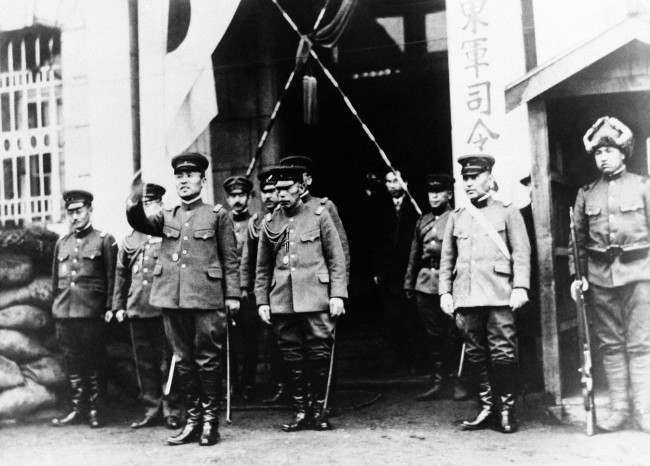
Japanese Major General Kenji Doihara, known as the “Lawrence of Manchuria”, in Peking, Nov. 18, 1935.

Fifty thousand students in and round Tokyo are undergoing rigorous training for war. Some of their numbers as they participate in maneuvers, equipped with bicycles to facilitate quick arrival at the front in Tokyo on Nov. 5, 1936.

Chinese legions on the Great Wall northwest of Peiping, China in mountainous country on Nov. 1, 1937.
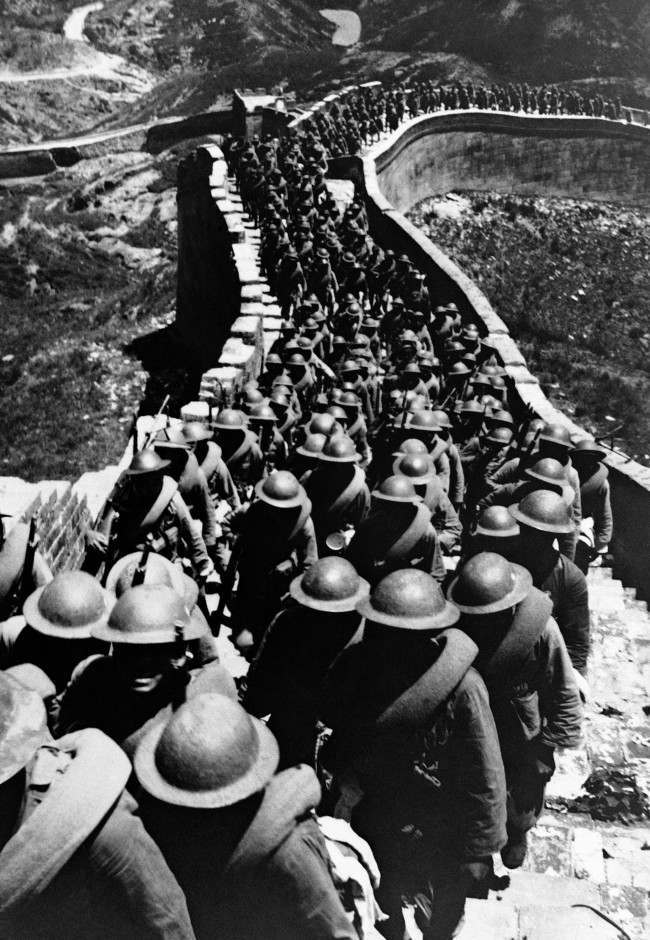
Japanese soldiers who have occupied the capital city of Nanking, China give some cakes from home to Chinese youngsters who apparently have no anti-Japanese sentiments when it comes to sweets, Jan. 22, 1938.
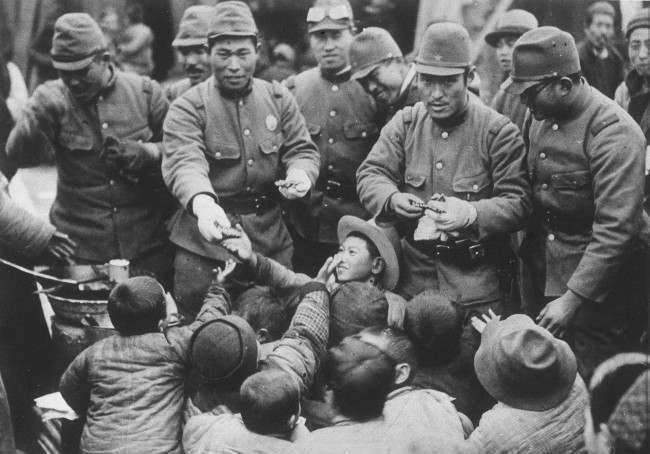
Endless line of Japanese infantrymen marching across the sweeping plains of Manchuria between Kanjurmiao and Changohumiao, two communication centres some fifty kilometers from the front lines on August 3, 1939, where fighting has again broken out between Manchukuo and Japanese troops on the one side and the soviet forces on the other.
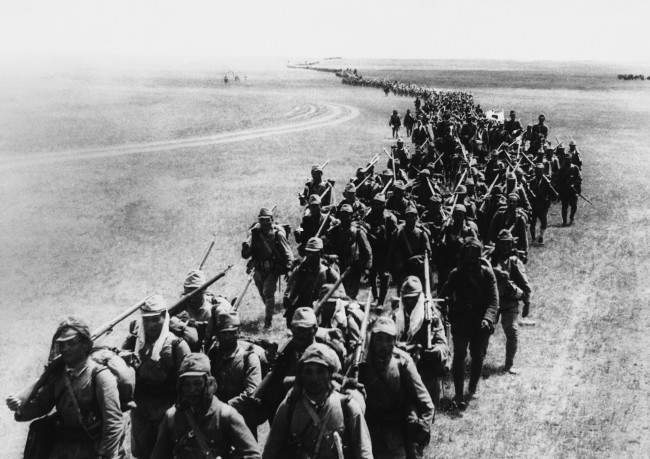
Children of Japan, Germany, and Italy meet in Tokyo to celebrate the signing of the Tripartite Alliance between the three nations, December 17, 1940. Japanese education minister Kunihiko Hashida, center, holding crossed flags, and Mayor Tomejiro Okubo of Tokyo were among the sponsors.
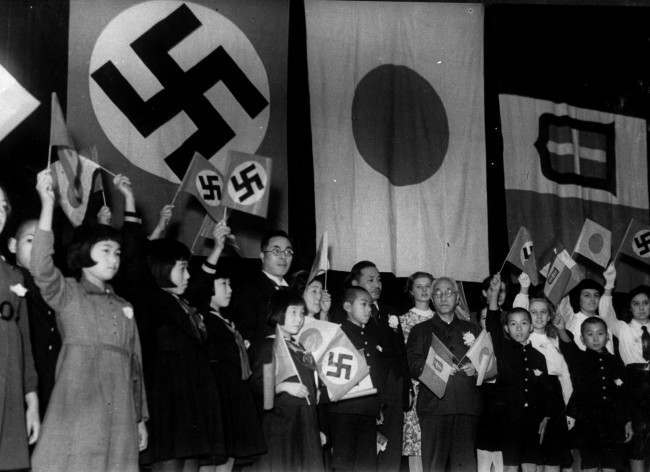
This picture, taken by a Japanese photographer, shows how American ships are clustered together before the surprise Japanese aerial attack
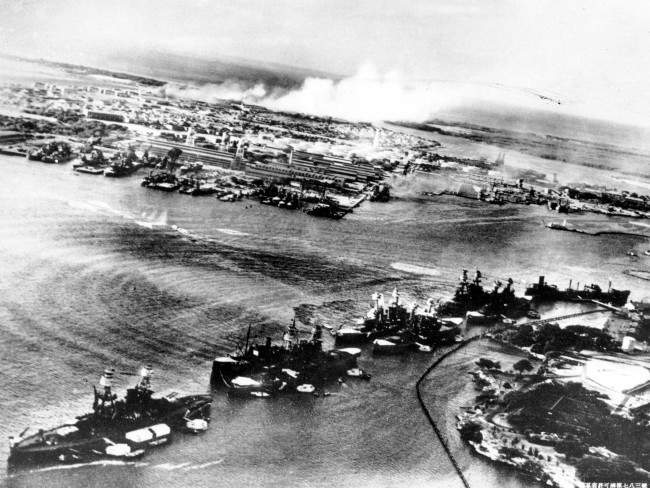
Sailors on a small boat rescue a USS West Virginia crew member from the water.

A Japanese plane dives.
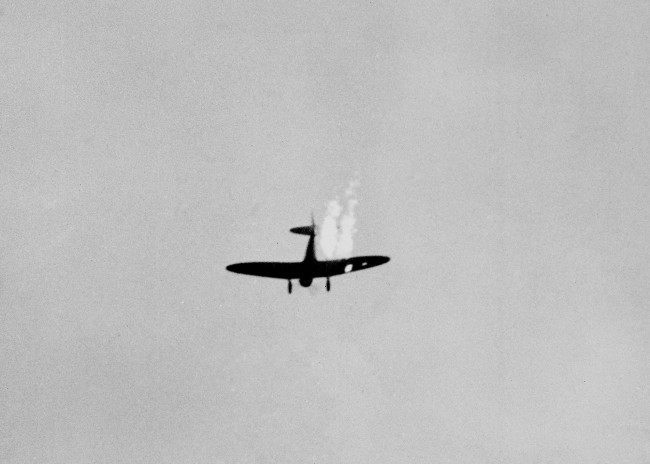
American ships burn during the Japanese attack on Pearl Harbor, Hawaii, in this Dec. 7, 1941 file photo.
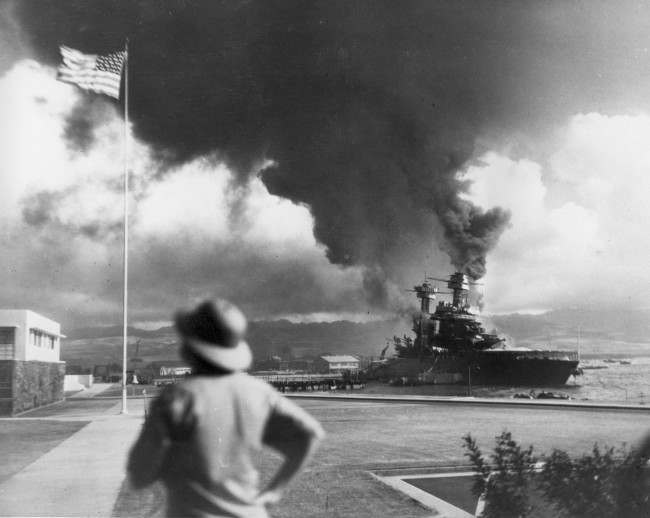
Japanese family move their household goods out on their lawn, for fear of the fire spreading to their home from a fire caused by a falling bomb only a half block away during the air raid on Oahu, Hawaii on Sunday, Dec. 7, 1941.
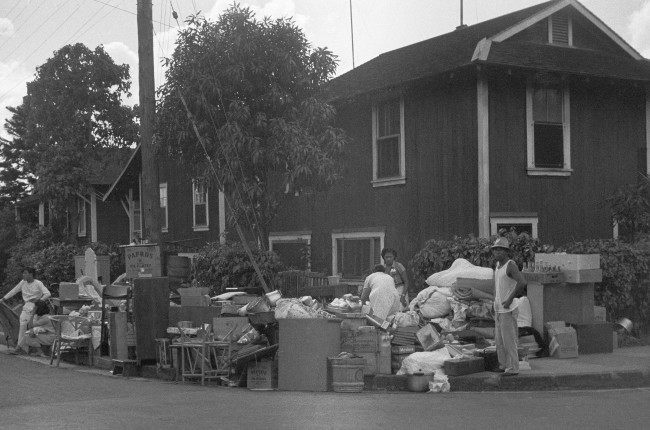
The Lunalilo High School situated near the Waikiki district which was almost totally destroyed by fire from a bomb which hit the roof at the center part of the main building on Dec. 7, 1941. Four fire companies fought to save the school. Several homes all around the school caught fire – but were saved by the fire fighters. All families for blocks around brought their personal belongings outside of their homes, fearing another attack.

White House reporters are dashing for the telephones, on July 7, 1941, after they had been told by presidential press secretary Stephen T. Early that Japanese submarines and planes had just bombed the U.S. Pacific fleet at Pearl Harbor, Hawaii.
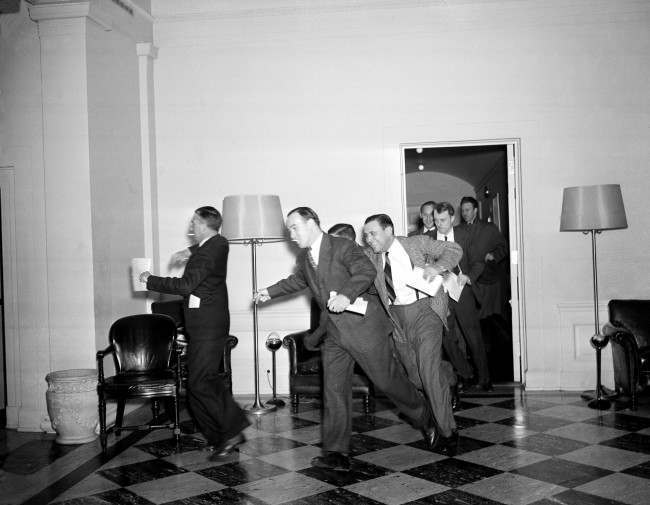
Troops man a machine gun nest at Wheeler Field, which adjoins Schofield Barracks in Honolulu.
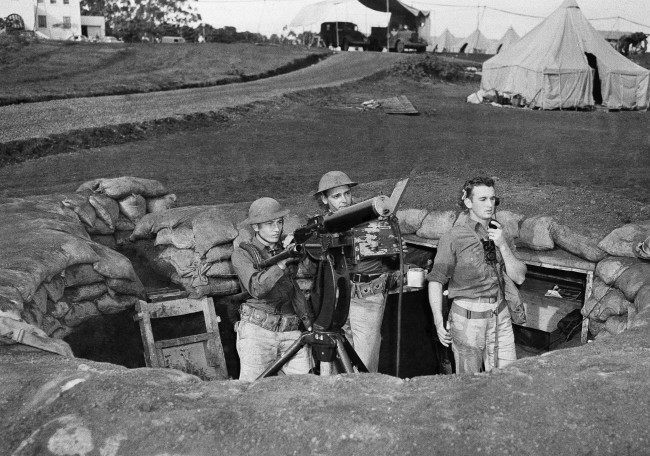
Dec. 7, 1941: People in Times Square New York buy newspapers reporting the Japanese attack.

Dec. 8, 1941: President Franklin Roosevelt speaks to a joint session of Congress in Washington after the Japanese attack.
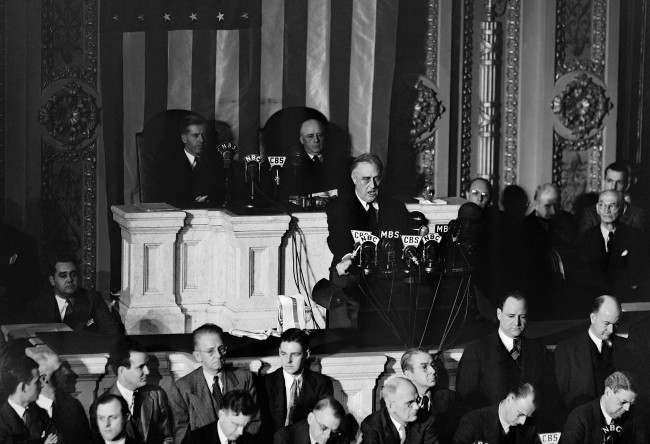
U.S. President Franklin D. Roosevelt signs the declaration of war following the Japanese bombing of Pearl Harbor, Dec. 7, at the White House in Washington, D.C., Dec. 8, 1941 at 3:08 p.m. EST. Watching from left to right are, Rep. Sol Bloom, D-N.Y.; Rep. Luther Johnson, D-Texas; Rep. Charles A. Eaton, R-N.J.; Rep. Joseph Martin, R-Mass.; Vice President Henry A. Wallace; House Speaker Sam Rayburn, D-Texas; Rep. John McCormack, D-Mass.; Sen. Charles L. McNary, R-Ore.; Sen. Alben W. Barkley, D-Ky.; Sen. Carter Glass, D-Va.; and Sen. Tom Connally, D-Texas.

Members of the Hearns Volunteer National Defense Corps spell the slogan “Remember Pearl Harbor” at a rally held on 14th St. between Fifth and Sixth Avenues in New York City, Dec. 27, 1941.
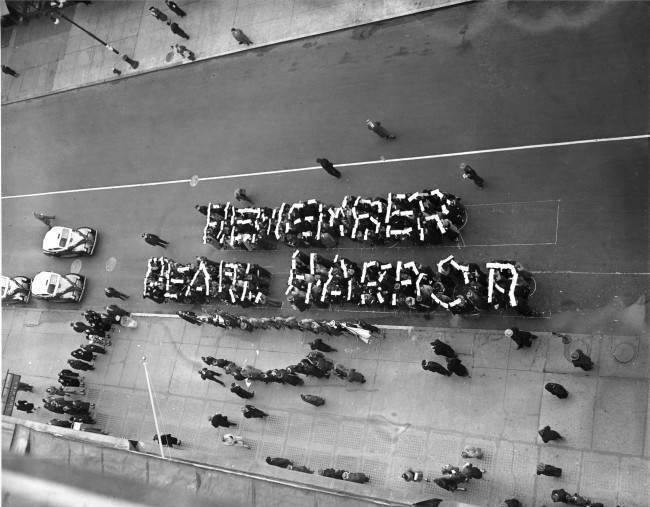
Mrs. Paul Titus (above), 77-year-old air raid spotter of Bucks County, Pa., carries a gun as she patrols her beat, Dec. 20, 1941. Mrs. Titus signed-up the day after the Pearl Harbor attack. ‘I can carry a gun any time they want me to,’ she declared.

Black paint is sprayed on an airplane plant to effect a blackout of the plant during night production in Burbank, California, Dec. 21, 1941, a measure taken following the Japanese attack on Pearl Harbor. The paint is a flat black, no-gloss type that will reflect no light.

Admiral Isoroku Yamamoto, commander of Japan’s Combined Fleet, is shown in Japan during World War II on Dec. 12, 1941. Yamamoto, who planned the attack on Pearl Harbor, received congratulations from the Emperor of Japan after the powerful British warship Prince of Wales and the battlecruiser Repulse were sunk Dec. 10 by Japanese torpedo aircraft off the coast of Malaya.
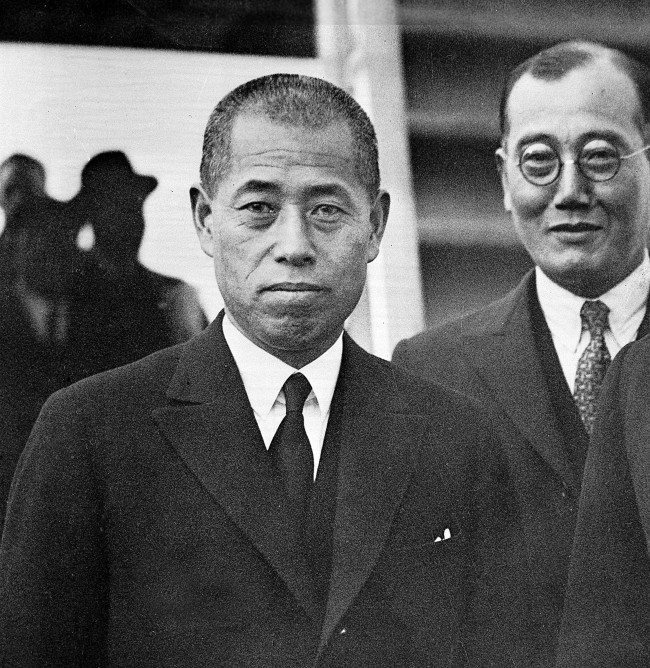
In this Dec. 15, 1941 file photo, Ruth Lee, a hostess at a Chinese restaurant, flies a Chinese flag so she isn’t mistaken for Japanese when she sunbathes on her days off in Miami, in the wake of the attack on Pearl Harbor. Lee was born in the U.S.
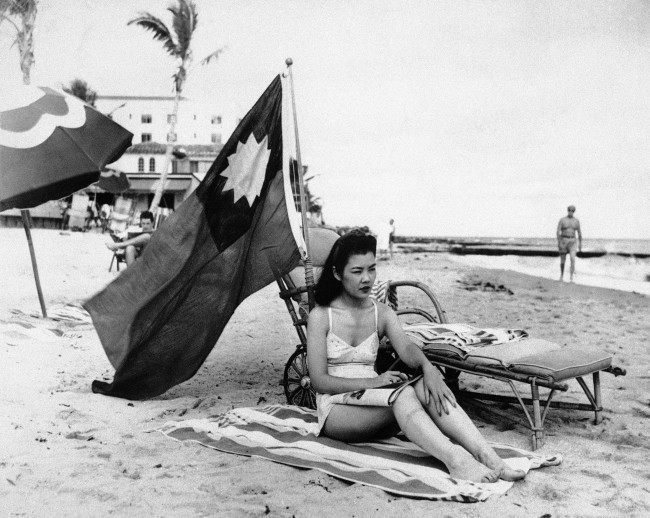
In this May 19, 1942 file photo, U.S. Army Air Corps Brig. Gen. Jimmy Doolittle poses with a new Air Corps poster in Washington. A month before, on April 18, Doolittle led 16 North American B-25s from the flight deck of the USS Hornet for the Army’s first air raid on Tokyo. Coming just four months after the Imperial Japanese Navy savaged the U.S. Pacific Fleet at Pearl Harbor, the Doolittle raid on Japan’s home did little damage, but lifted the spirits of Americans and electrified a world at war.

The latest idea of the San Francisco Citizens’ Win The War Committee to make residents of the city war conscious are a book of matches shaped like Japanese soldiers with covers bearing the legend “Strike ‘Em Dead. Remember Pearl Harbor.” Here is a large scale model of the book with three of San Francisco’s Chinatown residents– Mary Mammons, Dorothy Sun and Jessie Tai Sing, left to right adding decoration to the picture.

Mel Fan Keuren, 20 year-old gunnerÂs mate who was wounded at Pearl Harbor, came to Los Angeles on July 7, 1942, to repay a debt. He visited the Red Cross blood bank to donate a pint of blood, and said that eight transfusions given him after he was hurt saved his life. Nurse Bobbe Kester is taking his temperature and pulse.
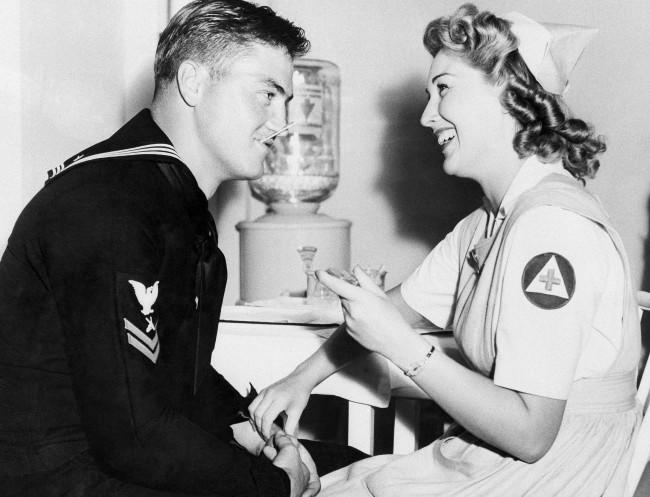
The Greater New York War Bond Pledge Campaign neared its end in Times Square on June 27, 1942, where pledges signed their autographs to big and little bombs with the happy thought that the missiles might fall on the Japanese capital. John Harvilas, a rigger who says he will leave for Pearl Harbor soon, pledged to buy a $1,000 bond and $100 bonds for his sisters. He is signing his name to the 2,000-pound ‘letter’.
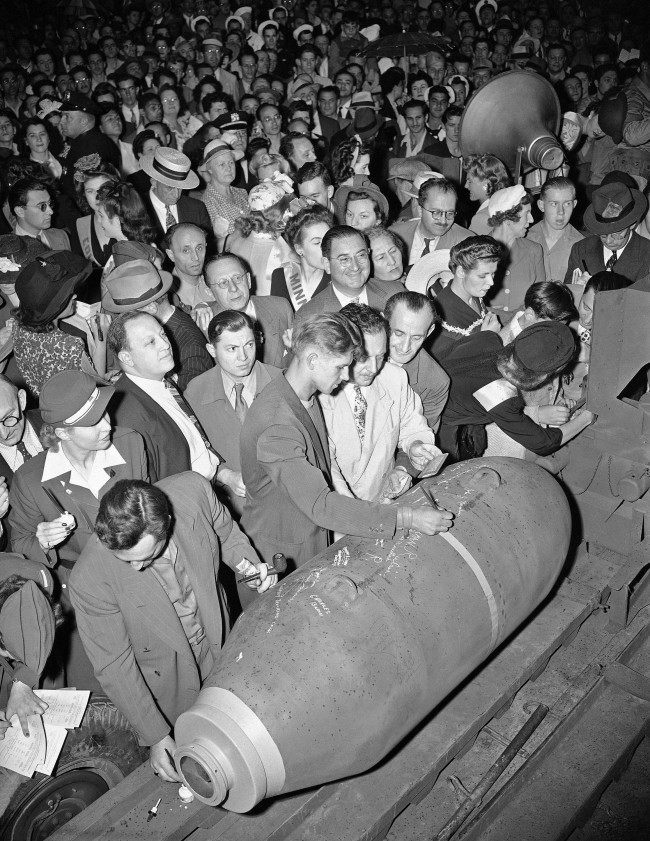
Members of the Submarine Base at Pearl Harbor, T.H. have adopted this kitten, June 19, 1942, born on a cruiser during the height of the Coral Sea battle.

Lieutenant George S. Welch, of Wilmington, Delaware, gets a hearty handshake from President Franklin D. Roosevelt at the White House in Washington, May 25, 1942 and his congratulations for shooting down four Japanese planes during the attack on Pearl Harbor on December 7. From left to right are Sen. James H. Hughes (D-Del.), Mrs. Hughes, Mrs. George Schwartz, Welch’s mother; George Schwartz, his stepfather, and Lieutenant Welch.

Brig. Gen. James H. Doolittle poses in Washington, D.C., May 19, 1942 during World War II. Doolittle led U.S. Air Force planes on air raid of Tokyo on April 18, five months after the Japanese attack on Pearl Harbor.

In this April 18, 1942 file photo, U.S. Army Air Corps Lt. Col. James Doolittle fastens a medal on the tail of a 500-pound bomb that he and the crew of 16 B-25 bombers dropped on Tokyo during a surprise raid. Coming just four months after the Imperial Japanese Navy savaged the U.S. Pacific Fleet at Pearl Harbor, the Doolittle raid on Japan’s home did little damage, but lifted the spirits of Americans and electrified a world at war. Date: 18/04/1942
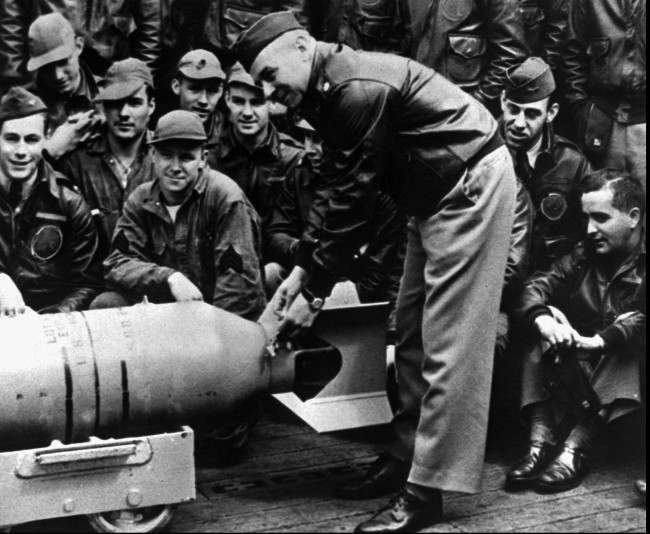
People of Japanese descent, relocated from the Seattle area, unload their belongings as they arrive at an internment camp in Puyallup, Wash., in April, 1942. They were among thousands of people forced from their homes in the name of national security following the attack on Pearl Harbor.
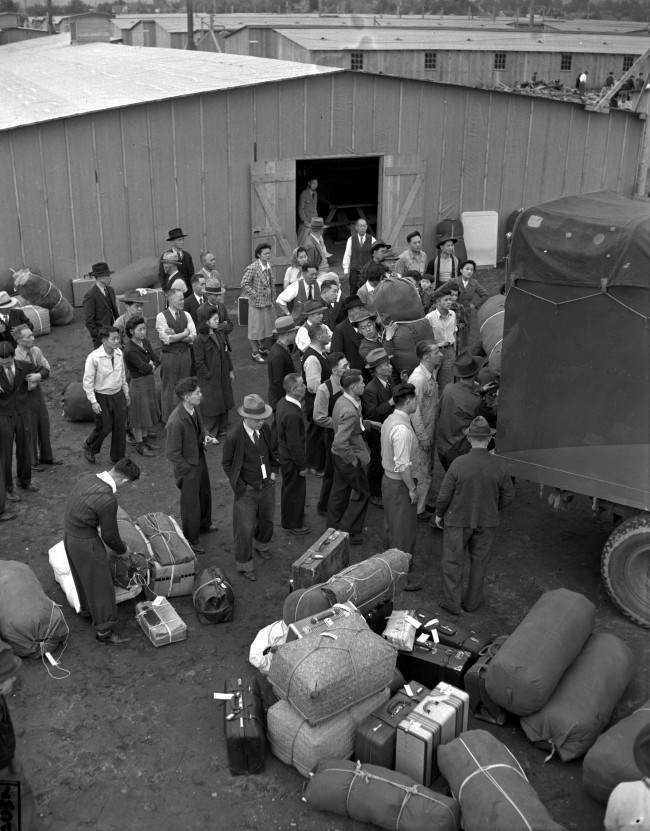
In this April 18, 1942 file photo, one of Lt. Col. Jimmy Doolittle’s B-25 bombers takes off from the flight deck of the USS Hornet for the initial air raid on Tokyo.
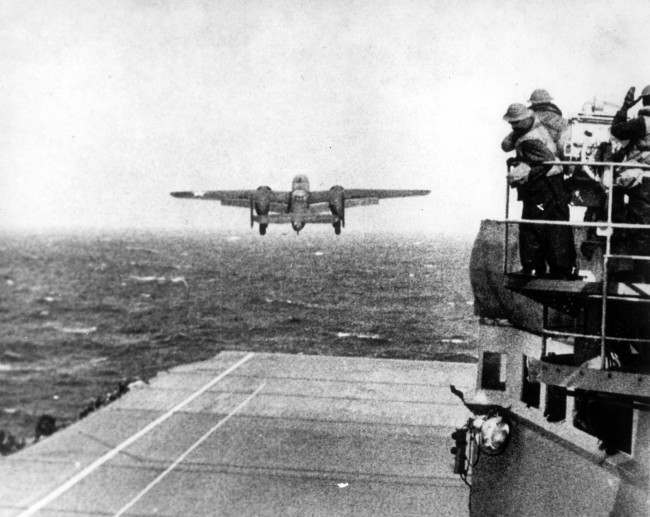
Behind blacked out windows so they could see none of the vital Panama Canal defenses, a group of enemy aliens ride on a train taking them from a Canal Zone detention camp to a port of embarkation for the U.S., and internment until the war ends April 7, 1942. The man in the white cap is a member of the Japanese navy, and the man beside him and the one in the foreground are Japanese Army reservists. They were rounded up in the Canal Zone soon after Pearl Harbor.
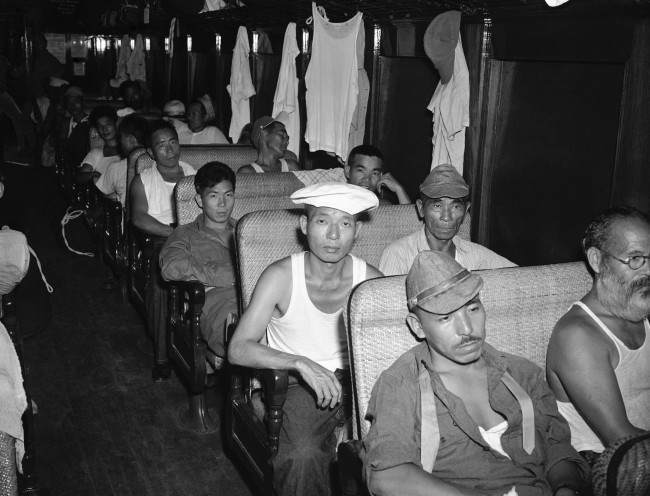
As military police stand guard, people of Japanese descent wait at a transport center in San Francisco April 6, 1942 for relocation to an internment center at Santa Anita racetrack near Los Angeles. They were among thousands of people forced from their homes in the name of national security following the attack on Pearl Harbor.
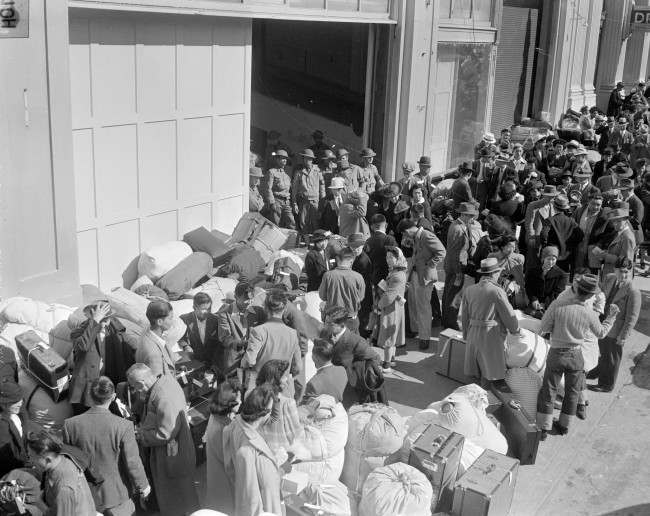
People of Japanese descent, relocated from the Seattle area, unload their belongings as they arrive at an internment camp in Puyallup, Wash., in April, 1942. They were among thousands of people forced from their homes in the name of national security following the attack on Pearl Harbor.
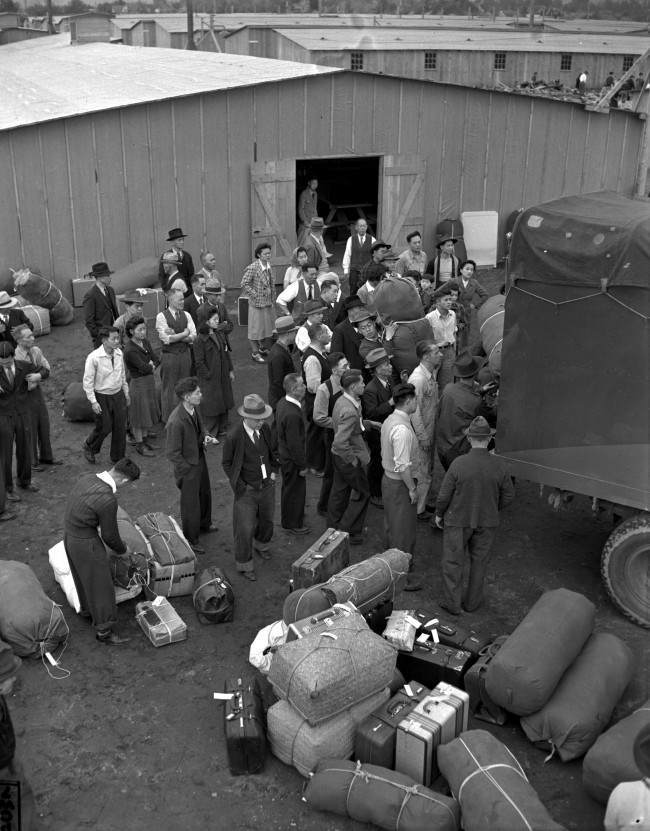
Navy Secretary Frank Knox pinned the Navy Cross for distinguished service on Ensign Thomas H. Taylor in Washington, March 17, 1942. Knox said that Ensign Taylor, though wounded, deafened because of broken ear drums, and suffering burns, took command of an anti-aircraft battery directing its fire accurately during the Japanese attack on Pearl Harbor on December 7.
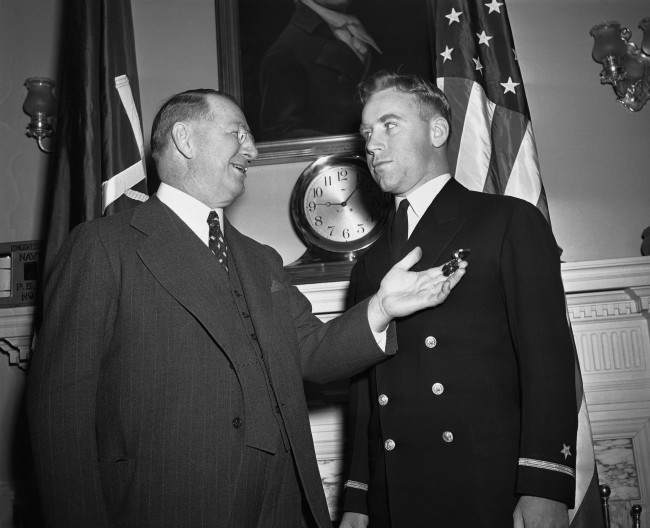
In the right foreground are 3 admirals shaking hands with 3 enlisted men. One of the men received Navy Cross, other 2 got Citation for rubber boat voyage ceremonies aboard an aircraft carrier in Pearl Harbor, Hawaii March 10, 1942.
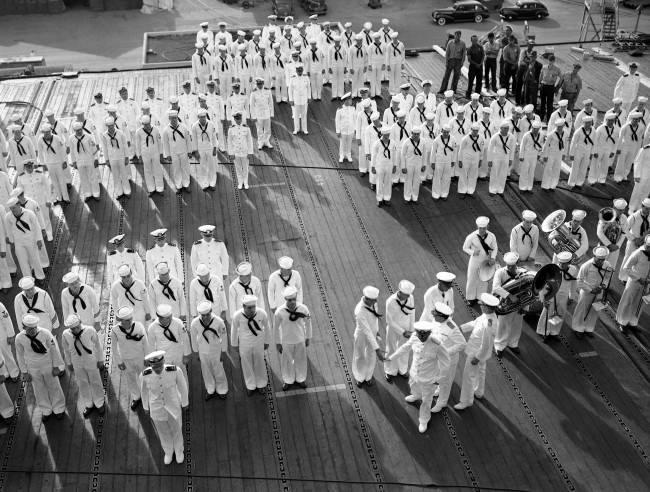
Clanking over his work at his home in Washington, D.C., on Feb. 22, 1942, is Harry Wilson Patterson, African American messenger at the Navy Department, who wrote the page of verse in tribute to the men who died at Pearl Harbor. On the wall is a poster he painted. The Navy issued the poem as an official release.

One of the world’s leading authorities on magnesium, a vital war metal, Dr. Fritz J. Hansgirg, 52-year-old Austrian, is in his quarters in the San Jose, Calif, jail on Feb. 4, 1942. He’s one of the aliens the FBI arrested right after the Pearl Harbor attack. There is no specific charge of espionage or sabotage against him. Prior to December 7 last, he supervised the huge permanent magnesium plant near San Jose. He invented a quicker method to get pure magnesium from the ore.
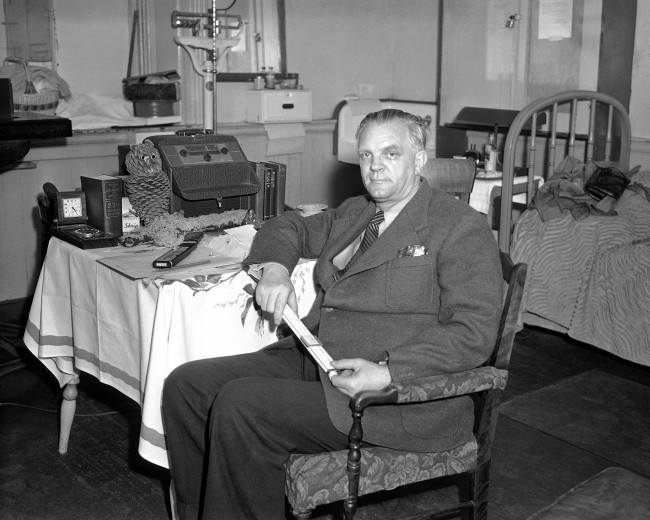
The battleship USS Arizona is partially visible as it rests on the bottom of Pearl Harbor, Hawaii, on Feb. 2, 1942.

American divers work around the aft turrets of the battleship USS Arizona at Pearl Harbor, Hawaii on Feb. 2, 1942 during World War II. The Arizona was sunk and destroyed during the Japanese aerial attack on Pearl Harbor
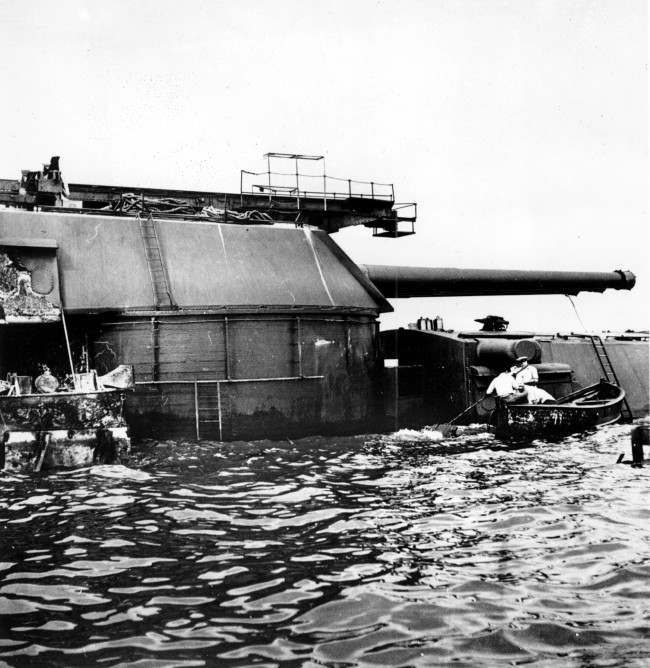
Leaving the White House after giving the president a full report on the surprise attack on Pearl Harbor, Associate Justice Owen J. Roberts, head of an investigation commission, tells reporters of the document’s contents in Washington, Jan. 24, 1942.

Hit by a Japanese bomb on December 7, this U.S. Army air corps repair shop in the Hawaiian Islands continues to operate, Jan. 13, 1942. The concussion blew out most of the glass, but the precious machinery was undamaged.
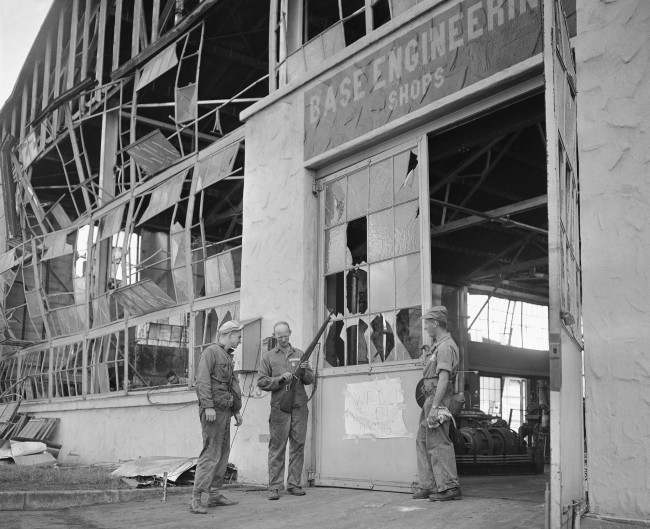
Members of President Roosevelt’s committee investigating the Japanese attack on Pearl Harbor, paused briefly for a photograph in the lobby of a Honolulu hotel, Jan. 4, 1942. Left to right: Admiral William H. Standley, Associate Supreme Court Justice Owen J. Roberts, Admiral Joseph N. Reeves, Brig. Gen. Joseph T. Mcnarney and Maj. Gen. Frank R. McCoy.
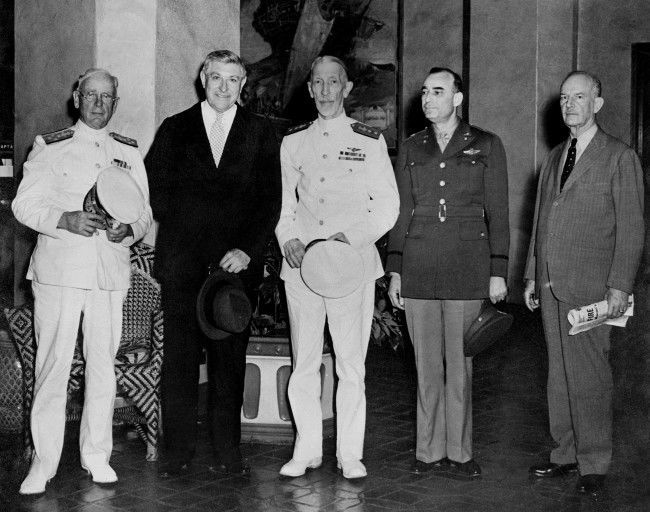
This is an undated photograph of Admiral Isoroku Yamamoto, who was the commander of Japan’s Combined Fleet and planned the attack on Pearl Harbor during World War II. He was gunned down by the U.S. Army Air Force while inspecting the Northern Solomon Islands on April 18, 1943. Yamamoto was born in Japan in 1884 and studied at Harvard University in the U.S.
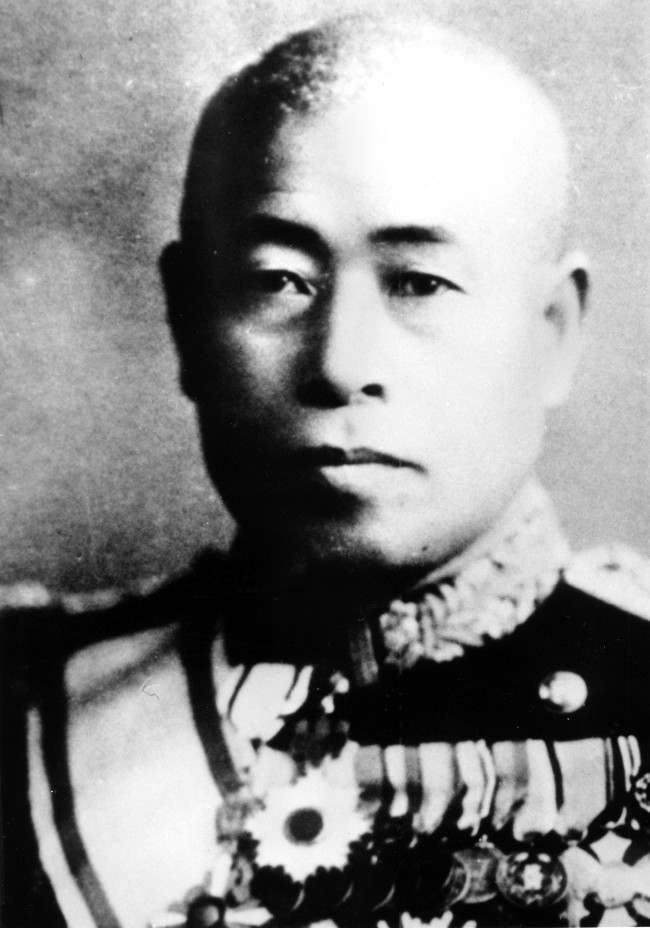
Japan’s Prime Minister Hideki Tojo, centre, salutes Japanes troops on his arrival in Manila, the Philippines, May 5, 1943.
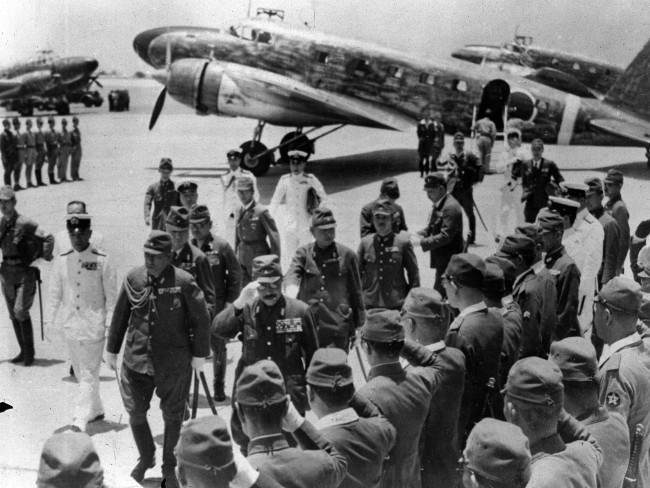
Japan’s war-time leader, Emperor Hirohito, in his army uniform in 1943
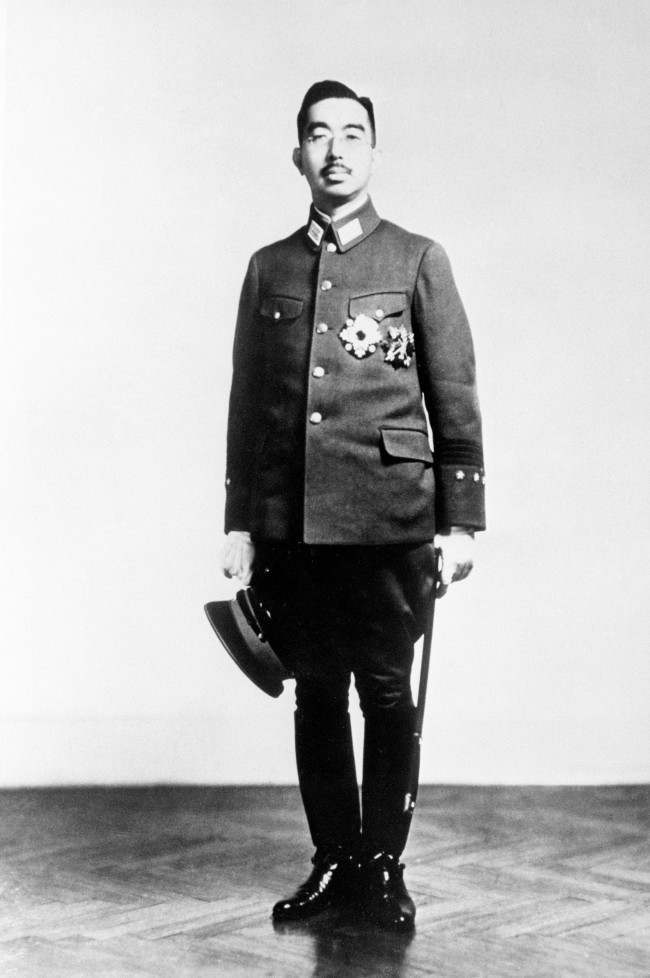
There are 7,000 Japanese evacuees in the Relocation center at Granada, Colorado, Feb. 23, 1943, and two-thirds of them are Nisez, American-born Japanese, who have recognized the peculiar problem of war their ancestry, makes for the United States government, and so they have adjusted themselves with relative cheerfulness to life in one-room barracks-type apartments and a few of the Issei. The alien-born and older Japanese, have been reconciled that close control over them is inevitable. (Upper): The Japanese language Editor and Stencil cutter of the Granada Pioneer are at work. Robert Asamoto, left, Chief Translator, translates the paperÂs English copy into Japanese, and Masaji Murai cuts the characters into a mimeograph stencil sheet.
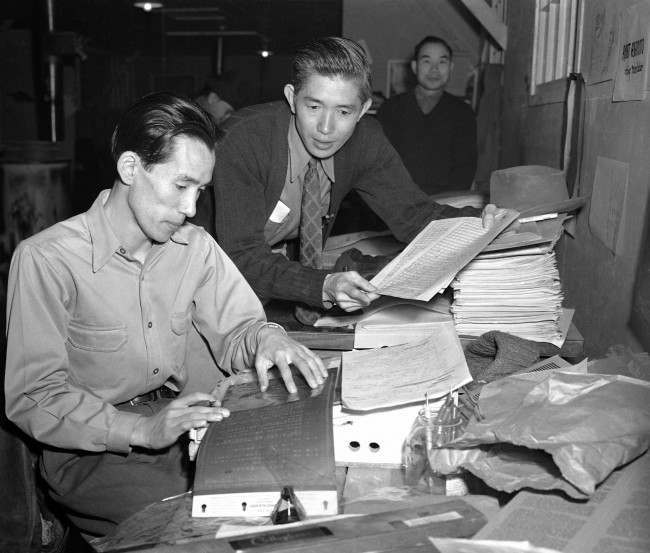
No country has suffered more indignities at the hands of the Japanese than has China. Consequently, no people has a bigger score to settle than have the Chinese. At the training command’s navigation school, groups of Chinese airmen, already trained as gunners. Pilots and bombardiers, learn navigation in a way that earns respect and admiration from their instructors. First Chinese to take the course, theirs will be the task of charting for China-the aerial course to Tokyo. Most of the students have already seen service in the war against Nippon as officers of the Chinese Army and Navy. Now, by benefit of the lend-lease act, necessary to take to the air against a brutal foe. A group of the students is listening to an instructor explaining the operation of a radio navigation training machine in San Marcos, Texas August 17, 1944.

A man looks over the expanse of ruins left the explosion of the atomic bomb on August 6, 1945 in Hiroshima, Japan. Some 140,000 people died here immediately. August, 1, 1945.
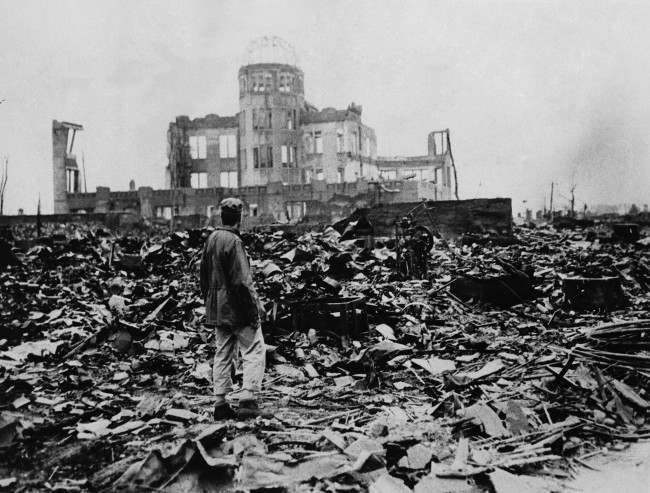
This is a 1945 photo of Japanese Capt. Mitsuo Fuchida who was the flight commander during the surprise attack.

This Feb. 23, 1945 file photo shows U.S. Marines of the 28th Regiment, 5th Division, raising the American flag atop Mt. Suribachi in Iwo Jima, Japan.
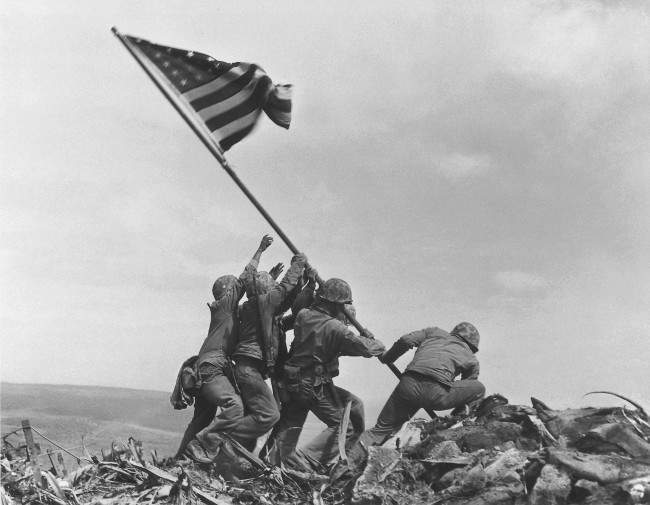
Servicemen, reporters, and photographers perch on the USS Missouri, in this Sept. 2, 1945, file photo, for the onboard ceremony in which Japan surrendered, ending World War II.
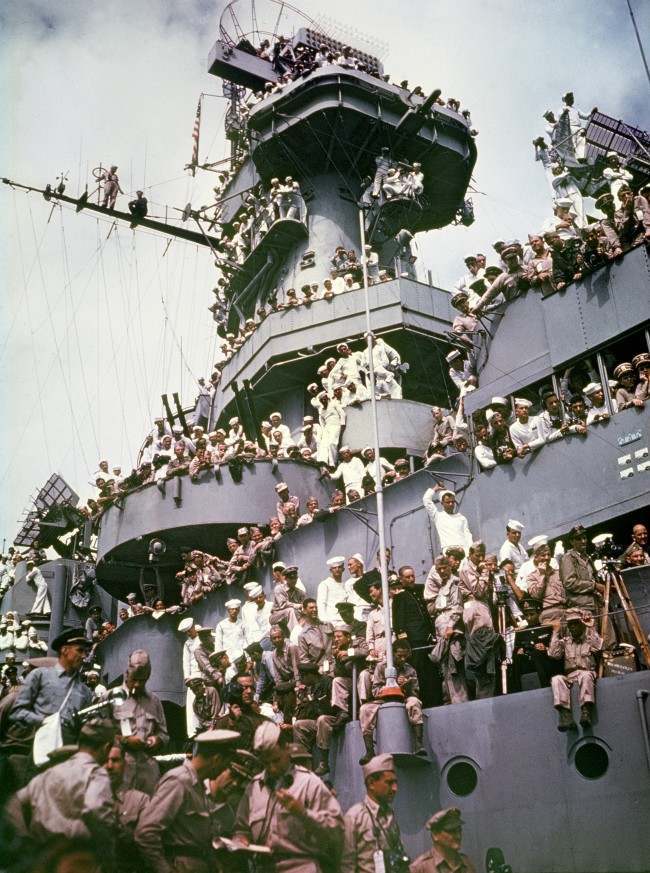
Gen. Douglas MacArthur signs the Japanese surrender documents Sept. 2, 1945, aboard the USS Missouri in Tokyo Bay. Lt. Gen. Jonathan Wainwright, left foreground, who surrendered Bataan to the Japanese, and British Lt. Gen. A. E. Percival, next to Wainwright, who surrendered Singapore, observe the ceremony marking the end of World War II.
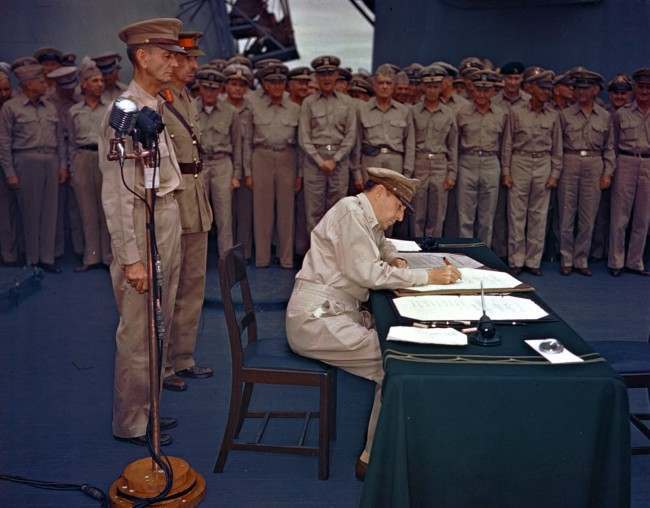
A Japanese family returns from a relocation center camp in Hunt, Idaho, to find their home and garage vandalized with anti-Japanese graffiti and broken windows in Seattle, Wa., May 10, 1945.

Japanese style for over two thousand men, women and children, Japanese born and Japanese descent who stepped ashore on Japanese soil to start life as subjects of the Emperor. Two hundred and eighty-five families who had renounced their rights as U.S. citizens were debarked from the former luxury liner Matsonia at Uraga port to become as most of the Japanese, hungry, cold and disillusioned as they see for the first time the conditions they will live under as subjects of the Emperor. Japanese arriving at this small port forty miles from Tokyo, then turned over to the Japanese civil authorities, college students, young children and the sick from every state in the Union and South America, later at the reception they were given rice, boiled celery and slice of apricot Christmas dinner  Japanese style. The sighs were many as the Matsonia proceeded to Yokahoma to pickup troops. The line forms to the right for this deluxe Japanese transportation to the reception center for the repatriates at Uraga port in Japan on Dec. 25, 1945.
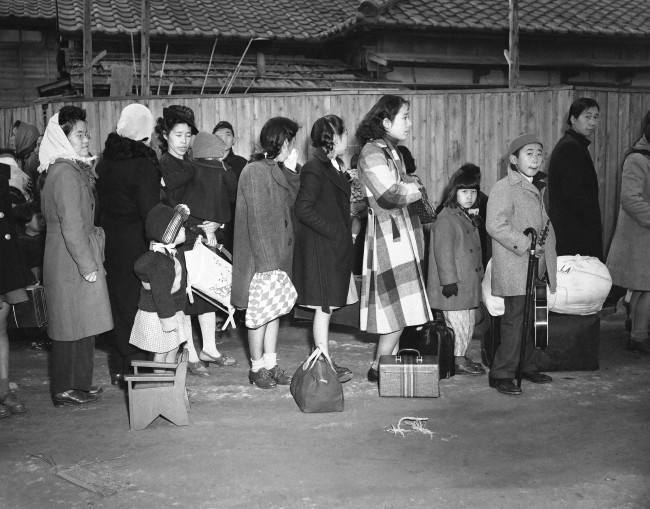
Would you like to support Flashbak?
Please consider making a donation to our site. We don't want to rely on ads to bring you the best of visual culture. You can also support us by signing up to our Mailing List. And you can also follow us on Facebook, Instagram and Twitter. For great art and culture delivered to your door, visit our shop.


